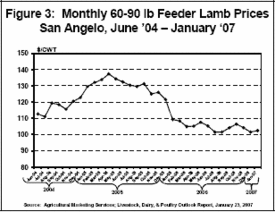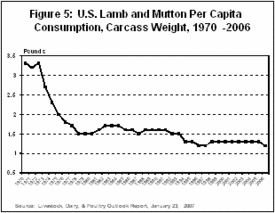AG-ECO NEWS
Vol. 23, Issue 4, February 14, 2007
Jose G. Peña
Extension Economist-Management
The U.S. Sheep Inventory Down Slightly After Two Years of Herd Rebuilding
Herd in Texas Down 1.8 Percent
After two years of indications of a herd increase, USDA’s February 2, 2007 Sheep and Goats report indicated that the size of the all sheep and lamb inventory in the U.S. on January 1, 2007, totaled 6.19 million head, down 0.8 percent from 2006, but 1.3 percent above 2004, when the size of the herd dipped to the lowest inventory since the peak of 56.2 million head in 1942. (See Figure 1). It appears that herd rebuilding could not be sustained by the extremely dry weather in the Southwestern part of the U.S. during 2006. The size of the herd remains 2.4 percent below the 6.321 million head in 2003. While the inventory of ewes one year old and older increased by 45,000 head (1.2%) the size of the total breeding herd decreased by 20,000 head (0.4%), with the inventory of replacement lambs under one year old decreasing 64,000 head (8.2%). This relatively large decrease in the inventory of ewe replacement lambs would indicate that the sheep inventory will continue to decline for, at least, the next two seasons. The size of herd declined in 18 states with 32 states showing a herd increase or no change to their herd size.

Shorn wool production in the U.S. during 2006 at 36.0 million pounds was down 3.3 percent from 37.2 million pounds produced in 2005. Sheep and lambs shorn totaled 4.85 million head, down 4.3 percent from 5.072 million in 2005. (See Figure 2). The average price paid for wool sold in 2006 was $0.68 per pound, down 3 cents from an average price of $0.71 per pound in 2005. The total value of wool clip at $24.4 million was down 7.1 percent from $26.3 million in 2005 and down 18.1 percent from a value of close to $30 million two years ago.

In addition to the drought of 2006, weak wool prices and weakening lamb prices may have had a significant influence on the inventory decrease.
Lamb Prices Down
Wool, lamb and mutton (meat from sheep one-year old or older) are the products of the sheep industry. As domestic wool trading continues very slow and feeder lamb prices weaken (see figure 3) significantly from 2005’s record highs, it appears that weakening wool/lamb trade will probably encourage a continued reduction of the inventory.
In an attempt to provide some market stability, last October, the Federal Crop Insurance Corporation (FCIC) approved the implementation of the Livestock Risk Protection (LRP)-Lamb pilot program, beginning with the 2007 reinsurance year. The American Sheep Industry Association (ASI) and its development partners have been working with the FCIC board and the Risk Management Agency (RMA) for nearly two years on the proposal for an LRP-Lamb pilot project. While details of the program have not been announced, the design of the project will allow producers and feeders to purchase insurance to protect them against unexpected declines in lamb prices. Implementation of this program is expected before the end of the year.
Imports
While U.S. lamb and mutton supplies have remained at a relatively steady annual average of about 369 million pounds since 1998, imports rose rapidly in the mid-1990’s as these lamb imports quickly found consumer acceptance in the U.S. (See Figure 4) Almost all of the U.S. lamb imports come from Australia and New Zealand. Imports account for close to half of domestic lamb and mutton consumption. 

Per Capita Consumption
After dropping significantly to record lows in the mid-90’s, U.S. Lamb and Mutton per capita consumption stabilized at about 1.3 pounds, but decreased slightly in 2006. (See Figure 5).
Texas Inventory Down
In Texas, the January 1, 2007 inventory decreased to 1.07 million head, down 1.8 percent from an inventory of 1.09 on January 1, 2004 to a herd of the same size as in 2005. Southwest Texas, where most of the sheep and lambs reside, probably suffered the severest part of the drought of 2006.
The inventory of breeding ewes, one year and older in Texas decreased by 15,000 head (down 2.2%) and the total breeding sheep and lamb inventory decreased by 50,000 head to 820,000 head on January 1, 2007, compared to a year ago. The inventory of replacement lambs dropped 30,000 head (down 22.2%) to 105,000 head. The herd in Texas had been steadily declining.
The inventory of 6.1 million head on January 1, 1961 in Texas alone was about the same size as the total current U.S. inventory. Texas remains the leading state with 17.3 percent of the total U.S. herd, compared to 17.4 percent a year ago.
